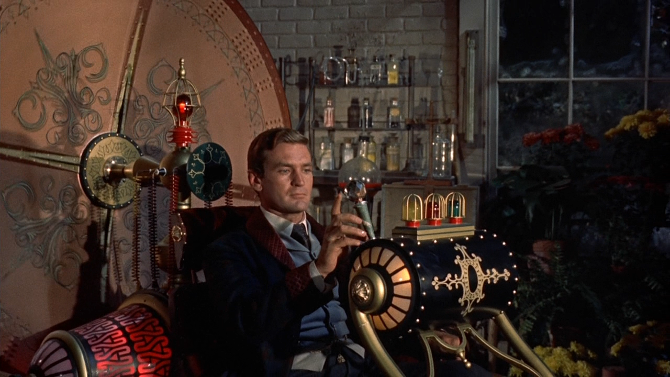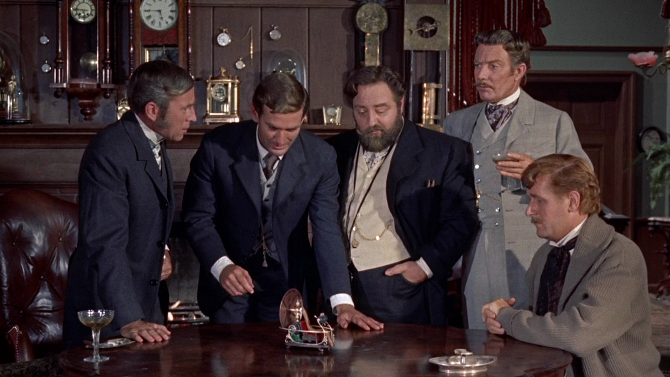One of my favourite films as a young boy – wholly capturing my imagination, was the 1960 George Pal directed sci-fi adventure The Time Machine, based on the 1895 novel of the same name by iconic author H.G. Wells. It is this movie that has possibly fuelled my intrigue with clocks, pocket watches and other time oriented things (motion pictures definitely fit within this grouping).
Set at the turn of the twentieth century, specifically on two days, December 31st, 1899/ January 5th, 1900, H. George Wells (Rod Taylor) is an inventor and time enthusiast, a peculiar fellow who has changed quite a bit in a short amount of time – at least according to his friends. Disenchanted by the warmongering of the British government (the Boer War) and the ways in which technology has been used to improve the efficiency of killing, the inventor looks to the future for hope in humanity.
Inviting his colleagues for dinner on the 5th after demonstrating his newest development (a miniature time travelling device that mirrors a full sized one) to best friend David Filby (Alan Young) and his three other companions on New Year’s Eve, he is late for his own party – leaving most of the snooty, British upperclassmen in a bit of a huff. Storming in as they eat, George is utterly dishevelled, clothing tattered and ripped, as if he was attacked and beaten by a group of savages.
This is the lead-in to his outlandish tale, as he recounts the story of how he travelled forward in time thousands of years. Filmed at the heart of the Cold War, in many ways, David Duncan’s adapted screenplay, which is vividly brought to life by Pal, is a warning of the dangers of wars that crop up time and time again in our history. Getting a brief viewpoint of different moments in the future each time he slows his time machine, George must witness the horrors of World Wars One and Two, as well as a vision of how the Cold War could have panned out (set ominously in 1966, six years after the movie was released). He also discovers other horrors that land closer to heart and home.
Winning an Academy Award for Best Special Effects (Gene Warren and Tim Baar), the pair, with Pal’s guidance, utilized time lapsed photographic effects to depict the passing of time (flowers blooming, a candle melting, weather changing, a female mannequin dressed in the latest greatest fashions, and a head rotting) – striking visions of time sped up. Another interesting effect, that of a volcano erupting onto the streets of a city, was done using oatmeal with orange and red food colouring. . . talk about a real Quaker (drum roll please!).
When George does arrive in the distant future (to specify, October 802,701), it is a world of unimaginable beauty as well as terrible horrors – much like the time he inhabited. Caught between a rudimentary vegetarian people (like a flock of sheep) called the Eloi and their subterranean-living cannibalistic rulers (of sort) – the Morlocks, he becomes fascinated by a blonde named Weena (Yvette Mimieux) – rescuing her from drowning while the rest of her dim-witted friends ignore the horrifying event.
The Eloi live in what once must have been an awe-inspiring civilization; dilapidated sphinx-like pyramids and other gargantuan buildings litter the natural landscape, while the Morlocks survive by way of machinery that produces oxygen below the Earth’s surface – the divide between the two factions itself came from another one of man’s folly-filled wars.
Touching on the subject of destiny and predestination, George is the type of man who does not truly buy into the idea – hoping that he can help shape the future into something worth living, unlike his uninspiring present. In a nice touch that further develops the relationship between George and his best friend Filby, Taylor and Young reprised their respective roles thirty-three years later for a PBS documentary called Time Machine: The Journey Back. . . though most of the film revolves around the making and restoration of the original prop. This short quasi-sequel is a nice touch, and holds true to the nature of the characters as they were once written – which is not too surprising, as original screenwriter David Duncan was recruited to carry on the narrative. Whit Bissell, who played another one of George’s friends in the picture (Walter Kemp), also makes a cameo, reminiscing about his acquaintance that disappeared so very long ago (this segment was set in 1932). Though it is not part of the original vision, one could argue that this sequel of sorts could help both sides of the predestination versus free will debate revolving around this motion picture. The documentary can be found on the Blu-Ray of The Time Machine. It also reveals that the stunning miniature model used at the beginning of the movie was kept by Pal, but was sadly lost when the director’s home burnt to the ground. As a final sidenote, Alan Young makes a cameo in the less engaging 2002 remake starring Guy Pearce – the only actor from the original to do so.
An intriguing Cold War era time travel science fiction film (with some romance to boot), The Time Machine fuses a rich story with solid performances, spot on direction and a fascinating score by Russell Garcia (early parts use a more traditional, time-like melody, while the future is envisioned with an electrical sound, using a theremin and other instruments), making for a more than memorable adventure. So, book it and take a trip back, or is it forward, to see The Time Machine – it is still one hell of a journey.


